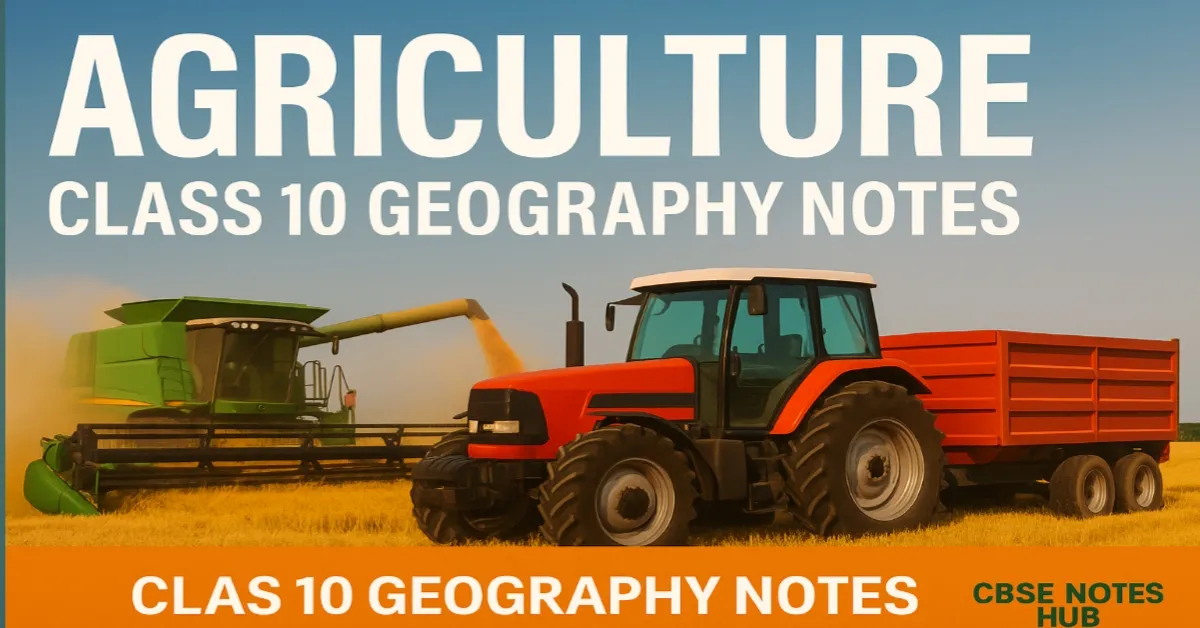As you all know, India is an agriculturally important country. More than half of India’s workforce is engaged in agriculture. This post helps you understand the importance of agriculture in India, the types of agriculture , farming seasons, and the crops grown during particular seasons.
Easy and Quick Revision Notes (Geo)
Ch – 4 Agriculture
India: Agriculturally Important Country
- Agriculture is the main occupation of two-thirds of India’s population.
- Agricultural products are exported from India to other countries.
Agriculture
- Primary activity of the world.
- Produces most of the food we consume.
- Provides raw material for various industries.
- Examples – Tea, coffee, spices.
Types of Farming
Primitive Subsistence Farming
- Practised on small patches of land.
- Uses old technology like hoe, dao, and digging stick.
- Depends on family or community labour.
- Fertilisers and irrigation are not used.
- Also called: Slash and Burn agriculture / Shifting cultivation.
Process – In this farming, the farmer clears a patch of land and produces cereals and other food crops for family use. After soil fertility decreases, the farmer shifts to another patch of land.
Completely dependent on monsoon.
Name of Slash and Burn Agriculture in Various Countries
| Names | Country |
|---|---|
| Milpa | Mexico and Central America |
| Conuco | Venezuela |
| Roca | Brazil |
| Masole | Central Africa |
| Ladang | Indonesia |
| Ray | Vietnam |
Names of Primitive Farming in Various Parts of India
| Names | Region / States |
|---|---|
| Bewar / Dahiya | Madhya Pradesh |
| Podu / Penda | Andhra Pradesh |
| Pama Dabi / Komang / Bringa | Odisha |
| Kumari | Western Ghats |
| Valse / Valre | South-Eastern Rajasthan |
| Khil | Himalayan belt |
| Kuruwa | Jharkhand |
| Jhumming | North-Eastern Region |
📌 Federalism in India – Class 10 Notes (Part 2)
Intensive Subsistence Farming
- Practised in areas of high population.
- It is a type of farming which is labour intensive.
- Modern tools are used.
- High doses of biochemical inputs and irrigation are used.
- There is enormous pressure on agricultural land.
Commercial Farming
- Large-size farms.
- Modern inputs are used like HYV seeds, chemical fertilisers, insecticides, and pesticides.
- Productivity is high.
- Crops are grown for trade (to sell in the market).
- Rice is a commercial crop in Punjab and Haryana and a subsistence crop in Odisha.
Plantation is also a type of commercial farming
- Single crop is grown on a large area.
- It is the interface of agriculture and industry.
- The production from it is used as raw material for industries.
- Examples – Tea, coffee, sugarcane, banana, etc.
Cropping Patterns in India
India has three cropping seasons –
(1) Rabi
(2) Kharif
(3) Zaid
Rabi season / Rabi crops
Rabi crops sown in – Winter (October to December)
Harvested in – Summer (April to June)
Major crops – Wheat, barley, peas, gram, and mustard
Major producing states – Punjab, Haryana, Himachal Pradesh, Jammu and Kashmir, Uttarakhand and Uttar Pradesh
Kharif season / Kharif crops
Sown in – Onset of monsoon
Harvested in – Sep, Oct
Major crops – Paddy, maize, jowar, bajra, tur, moong, urad, cotton, jute, groundnut and soybean
Major producing states – Assam, West Bengal, Odisha, Tamil Nadu
In states like Assam, West Bengal, and Odisha, three crops of paddy are grown in a year.
These are Aus, Aman, and Boro.
Zaid (cropping season)
Short season – During summer
Between Rabi and Kharif seasons
Crops – Watermelon, muskmelon, cucumber, vegetables, and fodder in India.
📌
Federalism – Class 10 Notes (Part 1)
📌
Romantic Imagination and National Feeling – Class 10 Notes (Part 4)

